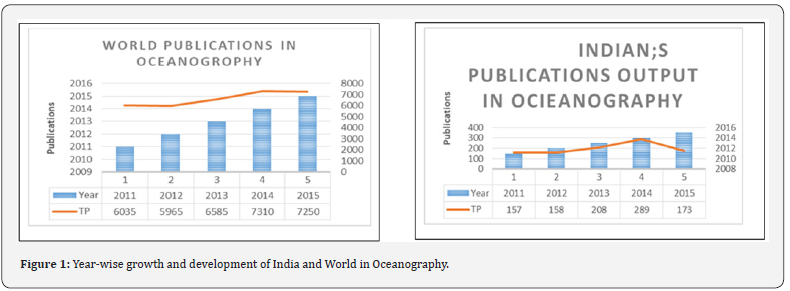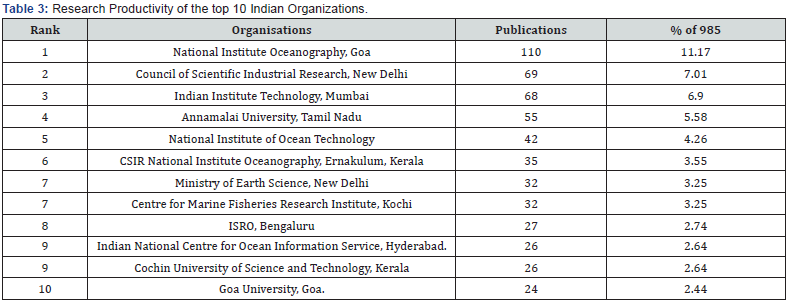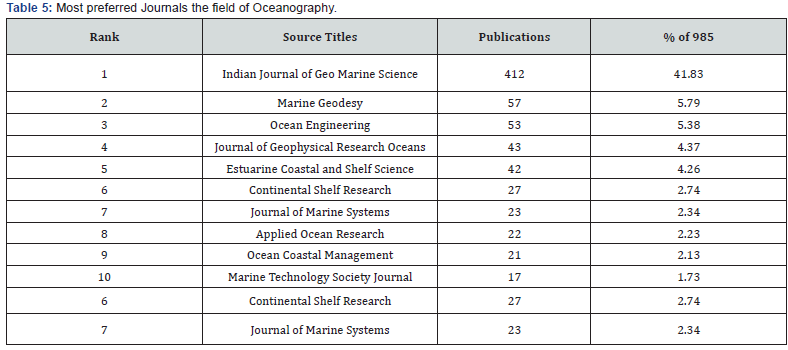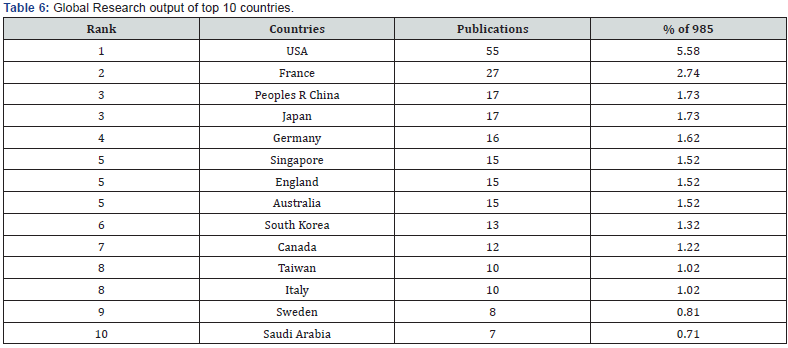Scientific Productivity of Oceanography Literature: A Scientometric Analysis- Juniper Publishers
Juniper Publishers- Journal of Oceanography
Abstract
The study examines India’s performance based on its publication output in Oceanography literature during 2011–2015, based on various aspect of the oceanography research such as growth of papers (year wise), most prolific authors, document types, institutions involved, Sources wise distribution, subject wise distribution of publications and international collaboration linkages. The study reveals that, most of the researchers preferred to publish their research results in journals; as such 1.92% of articles were published in journals, more numbers of articles were published in the year 2015, the study shows that overall average citation per paper was 2.32, all the studies will be helpful for its further development. Further this study also identified to analyses coverage growth rates, coverage growth rates, source wise. Degree of collaboration, institutions wise and Geographical wise distribution of the literature.
Keywords: Scientometrics; Oceanography; Relative growth rate; Doubling time; Collaboration
Introduction
Scientometric study is a quantitative of written communication and it is essential for the effective management of libraries within their budget provisions. The quantitative data is used to keep control over the cost of library collection and essential books and periodical collections that satisfy the need of the readers. Librarians began to use quantitative techniques in their day to day administration, especially to evaluate libraries and their services. The scientometric studies play a vital role in the process of information research. Many reasons are responsible for the development of research in scientometric and they are discussed here. The major focus of the study is to apply the Scientometric analysis with a view of analyse the performance of research output on Oceanography in India. Present study focuses attention on the growth of literature, authorship pattern, journal coverage, institutions involved in active research etc. The scientometric studies play a vital role in the process of information research. Scientometric studies have shown that all the pieces of published information do not have equal importance. Present study focuses attention on the growth of literature, authorship pattern, journal coverage, institutions involved in active research etc. Citation studies are recognized as an indicator of influence of published work on the scientific community. This study attempts to analysis the performance of Oceanography research output in terms of its content and coverage, growth rates, areas of research concentration, author productivity, and authorship pattern, journals and articles and other means of assisting the peer review procedure. Performance of research institutions in promotion of Oceanography research is also given due emphasis [1].
Literature Review
Several country – wise studies on Oceanography were conducted, particularly in countries like now a day’s scientometrics is one of the truly interdisciplinary research fields extended to almost all scientific fields. Scientometrics applications are used to measure scientific activities, mainly by producing statistics on scientific publications indexed in databases [2], presented a study based on references appended to the articles published in open access e-journals AgBioForu [3], have performed a scientometric analysis of all Tsunami related publications as per the Scopus (TM) database during 1997 – 2008 including authorship pattern as one of the parameter for the study [4], have carried out study to know the characteristics of literature and degree of collaboration [5], have examined the Collaboration Pattern in Indian Contribution to Chemical sciences literature by scientific output and research performances of individual, institutional and country coloration etc. [6], have studied the Indian research output in diabetes during 1992 – 2009 on several parameters including its growth, rank and global publication collaboration.
Objectives
The main objectives of this study are to study performance of Indian Research in Oceanography during 2011-2015., based on publications covered in Web of Science (WoS) citation database. In particular, the study focuses on the following objectives.
(i) To study the growth of world and Indian research output;
(ii) To identify the source of publications;
(iii) To identify the Institutional productivity and quality of output;
(iv) To study Strong and weak areas of research;
(v) To identify the highly productive journals;
(vi) To study of International collaboration
(vii) To identify the Doubling Time growth rate of India & World.
The results presented in the study are based on raw bibliographical publications data extracted and downloaded from the Science citation index expended version (Science) (Web of Science) published by Clarivate analytics. This study is based on the publications output as indexed by Web of Science database for the period 2011 to 2015. The study uses 5 years publications data on Indian oceanography from Web of Science database. The growth rate of output in terms of research productivity is analysed, by using Web of Science database. For analysing the data only in Excel. The Relative Growth Rate (RGR), Doubling Time (Dt) and other indicators has been calculated. Search string used for the data retrieval is SU=(Oceanography) AND Timespan=2011-2015. Databases=SCI-EXPANDED, this search criteria yielded 985 records.
a) Relative Growth Rate: is the growth rate relative to the size of population. It is also called as the exponential growth rate or continuous growth rate with reference to scientific literature publication time, Relative Growth Rate (GR) is the increase in the number of publications per unit time. The formula for calculating the mean R
R = W2 - W1/T2 - T1
Where
R = mean relative growth rate over the specific period of intervals;
W1 = Log W1 (natural log of initial number of publication);
W2 = Log W2 (natural log of final number of publication);
T2 - T1 = the unit difference between the initial and final time
This formula even holds good for the calculation of RGR Subject wise
Doubling Time (Dt) Doubling Time (Dt): The doubling time is the given period required for quantity to double in size or value. This can be calculated by using the formula.
Doubling time Dt = 0.693/R
Here, Dt (P) = average doubling time of publications.
Results and Discussion
Year-wise growth and development of India and world in oceanography
Table 1 depicts the oceanography research output of World and India, Citations and Average Citations per publications of India. India has produced 985 publications, and received 2,286 citations; Average Citations per Publication is 2.32. As per the web of science data, cumulative publications growth, the output of India had increased from 157 publications during 2011 to 173 publications during 2015, and 2014 India has published the highest publications i.e. 289 papers. India’s publications are gradually increased year by year. Indian global publications share during 2011 to 2015 was 2.97%, which has increased from 2.60 in 2011 to 3.95 in 2014 and slight decrease in 2015. The global research output in oceanography research has increased from 6,035 in 2011 to 7,250 in 2015. The trend shows a steady and significant increase in the publications (Table1) (Figure 1).


TP = Total Publications; TC = Total Citations; ACP = Average Citations per Paper.
Source wise Distribution of Research output of India in the field of Oceanography
Table 2 indicates the document wise distributions of publications on Oceanography. Those documents are classified into 4 categories according to the nature of publication. The data from the table revels that most prevalent form of publication is journal article with India were 984 records. Article as a source of publication (950 publications) take the first place, followed by Review (17 publications), Editorial Material (13 Publications) and in the form Correction (4 publications). A record in Web of Science Core Collection with a Document Type of Correction»means the journal in which the original article appeared had to issue a correction to that article in a later issue. *The Correction record will always have one cited reference, which is a reference to the original article. In order to more closely link published corrections to the original articles, the policy for indexing corrections changed in late 1997. The previous policy was to index the correction article with simply CORRECTION or ADDITION as the article title. Published corrections are now indexed with the original article title amended with the volume, pages, and year of the original article, as shown below – this allows both the original article and the correction to be retrieved in searches [8].

Research productivity of the top 10 Indian organizations.
The Table 3 displays results of top selected institutions on their highest publications according to the web of science database. National Institute of Oceanography, Goa, contributed the highest publications to the field of oceanography, i.e. 110 publications with 11.17%, followed by Council of Scientific Industrial Research with 69 publications (7.01%), Indian Institute of Technology with 68 publications (6.90%), Annamalai University, with 55 publications (5.58%), National Institute of Ocean Technology, with 42 publications (4.26%), CSIR National Institute Oceanography, with 35 publications (3.55%), Ministry of Earth Science and Centre for Marine Fisheries Research Institute with each 32 publications (3.25%), Indian Institute of Technology, Delhi, with 237 publications (2.11%), ISRO, with 27 publications (2.74%), Indian National Centre for Ocean Information Service and Cochin University of Science and Technology, with each 26 publications (2.64%) and Goa University contributed 24 (2.44) publications.

Top 10 sub-disciplines of oceanography
Table 4 indicates that the sub-fields research priority in oceanography research of India. Engineering, Marine Freshwater Biology, Geochemistry Geophysics, Remote Sensing, Geology, Meteorology Atmospheric Science, Water Resources, Chemistry, Mining Mineral Processing, Environmental Science Ecology, were considered on the basis of the highest number of publications, as per the categorisation of Web of Science. In the context of Indian research in oceanography during the period 2011 to 2015. The maximum research priority (132 publications, 13.40% share) is assigned to Engineering in India, followed by Marine Freshwater Biology (127 publications, 12.89% share), Geochemistry Geophysics (63 publications, 6.40% share), Remote Sensing (57 publications, 5.79% share), Geology (51 publications, 5.18% share), Meteorology Atmospheric Science (32 publications, 3.25% share), Water Resources (28 publications, 28% share), Mining Mineral Processing (16 publications, 1.62% share) and Environmental Science Ecology (13 publications, 1.32% share).

Top productive Indian journals in oceanography
The top most productive journals publishing India’s research papers in oceanography contributed 717 papers, which accounts for 72.79% share in the cumulative publications output of India during 2011 to 2015. Indian Journal of Geo Marine Science, has published 412 (41.83% of total output) articles, followed by Marine Geodesy, with 57 (5.79%), Ocean Engineering with 53 (5.38%) articles, Journal of Geophysical Research Oceans with 43 (4.37%) articles, Estuarine Coastal and Shelf Science with 42 (4.26%) articles, Continental Shelf Research with 27 (2.74%) articles, Journal of Marine Systems with 23 (2.34%) articles, Applied Ocean Research with 22 (2.23%) articles, Ocean Coastal Management with 21 (2.13%) articles and Marine Technology Society Journal with 17 (1.73%) articles, are the most preferred sources in which Indian scientists have published their articles (Table 5).

Global output of top 10 Countries.
Table 6 depicts the international collaborative partners of India with top 10 countries during 2011-2015. The share of International collaborative publications in the oceanography research output India achieved 24.06% with 237 publications of their total output during the period. The largest number of collaborative publications (55) of India in this research was with United States with 5.58% share, followed by France with 27 publications (2.74%) share, Peoples R China and Japan with each 17 publications (1.73%) share, Germany with 16 publications (1.62%) share, Singapore, England and Australia with each 15 publications (1.52%) share, South Korea with 13 publications (1.32%), Canada with 12 publications (1.22%) share, Taiwan and Italy with each 10 publications share (1.02%) share, Sweden with 8 publications share (0.81%) share and Saudi Arabia with 7 publications (0.71%) share.

Annual growth rate and doubling time of world and India
The following table (Table 7) represents the chronological distribution, Relative Growth Rate (RGR is the growth rate relative to the size of population or continuous growth rate with reference to scientific literature publication time, also known as the increase in the number of publications per unit time) and Doubling Time (DT is the given period required for quantity to double in size or value) of World and Indian publications in the field of oceanography during the period 2011 to 2015. DT is the period of time required for a quantity to double in size or value. Indian RGR decreased from 0.70 in 2011 to 0.19 in 2015 in the same sense World annual RGR decreased from 0.69 in 2011 to 0.25 in 2015. Thus the rate of growth of publication was decreased, the corresponding DT was increased. When we compare the respective growth and the doubling time for World and India, it’s almost same, this means to say that the growth is constant for both the countries.

Conclusion
The present study provides useful data on oceanography research in India in relation to developments in the world on comparative basis. It provides opportunity to the planners and policy makers in both the countries to use the findings in assessing the R & D initiatives in India. The study gives a scientometric description of the research performance of countries status in world. The aim of scientometrics is to provide quantitative characterizations of scientific activity. The assessment of countries productivity can be measured by the counting of research publications in the journals and proceedings, and the number of citations received in those publications. Scientometric indicators have been used as valuable indicators to quantitatively measure the output of scientific research. They merely show part of scientific enterprise, which is activity with diverse aspects. However, there is nothing on par with these indicators in terms of the abundance of information contained.
This study reveals that India has produced 985 papers, and received 2,286 citations and World produced 33,145 papers, and received 1,75,793 citations in the field oceanography during the period 2011 to 2015. Both countries publications are gradually increased year by year. As per the web of science data, cumulative publications growth, the cumulative output of India had increased from 157 publications during 2011 to 173 publications during 2015. World has published 6,035 publications in 2011and 7,250 publications in 2015.
Compared with the last 5 years data of publication size and the publication quality, the possibilities are that India may emerge as a stronger nation in oceanography research as compared to other developing countries in the near future. Also the top journal in each of the respective areas under oceanography is additional information for the professionals/ scholars during his research work.
To Know More About Journal of Oceanography Please Click on: https://juniperpublishers.com/ofoaj/index.php
Comments
Post a Comment